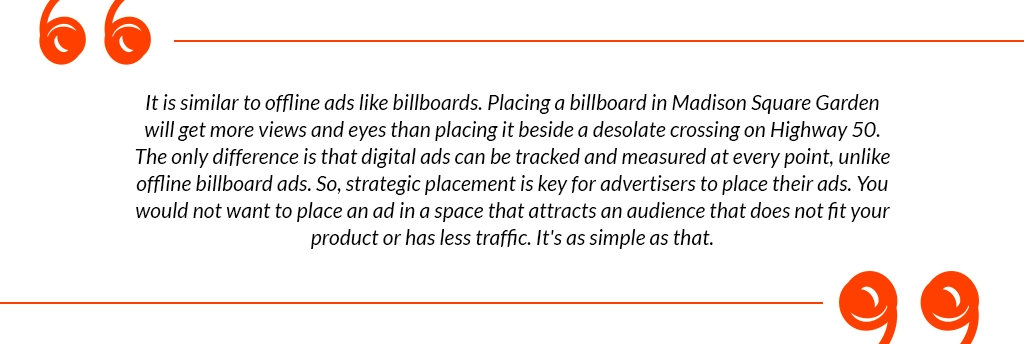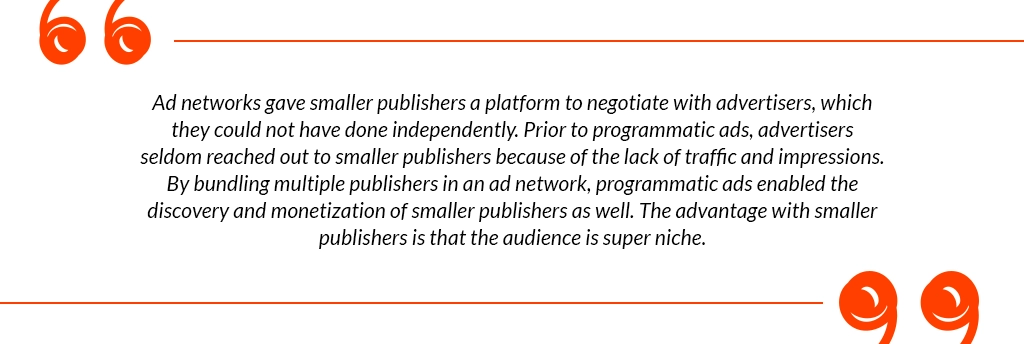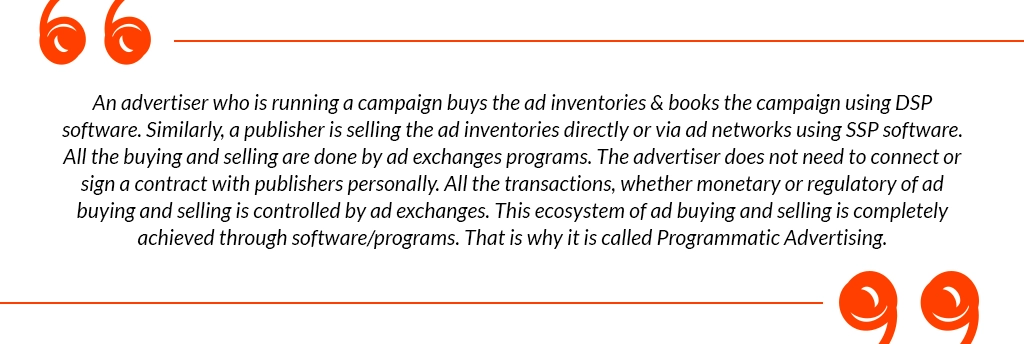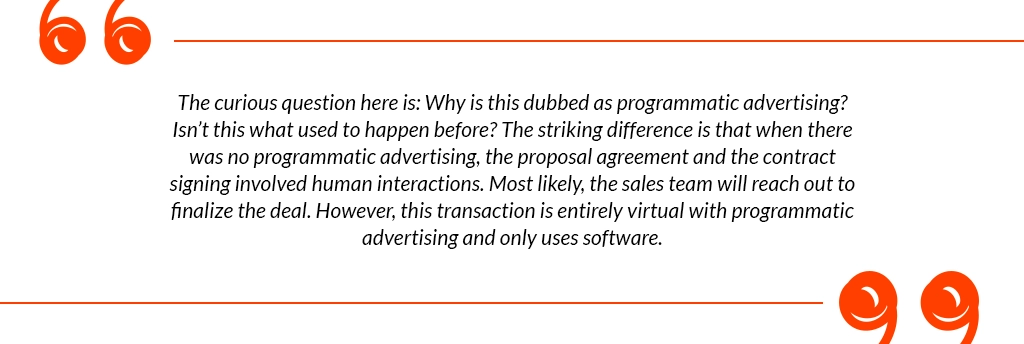What is Programmatic Ad and how does it work?
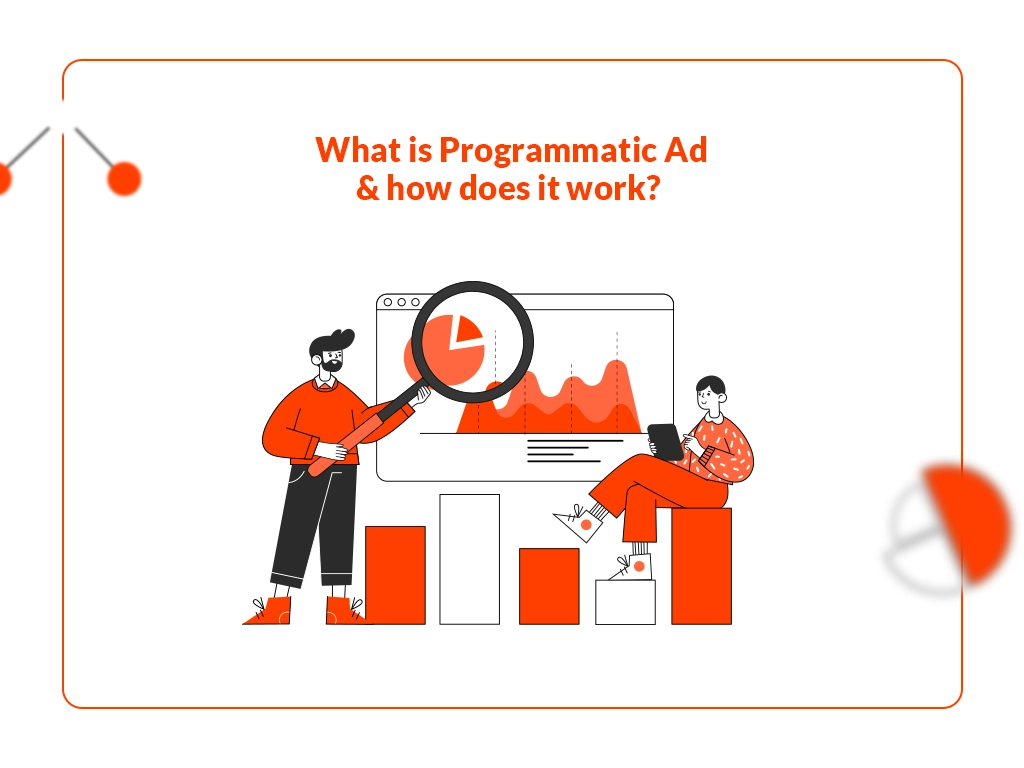
Introduction to Programmatic Ad
Programmatic Ad is easily the most talked about yet the least understood subject in media buying and placement today. Today, programmatic ads fit very well within the current context of AI and ML.
With a flurry of AI-powered technology in every sphere, marketing and advertising are no exceptions. Referred to as programmatic ad, it is different from non-programmatic ads. In non-programmatic ads, you must identify the audience and decide on an ad budget per your prior research & ongoing campaign insights. Everything needs to be done manually. Whereas, for programmatic ad, you can manage multiple ads across multiple real-time bidding networks with automation, artificial intelligence, and machine learning capabilities.
In this blog, I’ll explain programmatic ad step-by-step. What are the different types of programmatic ads you can run? And how does a programmatic advertising ecosystem look like?
Let’s dive straight in.
What is Programmatic Ad?
The buying and selling of media placements and ad inventories through programs packaged as software is called Programmatic Ad. The programmatic advertisements that we run are characterized by three aspects:
i. Data Driven:
Programmatic ad leverages data-driven insights to target specific audiences based on demographics, interests, and behaviors, maximizing the relevance and effectiveness of advertisements.
ii. Ad Buying:
Programmatic ad streamlines ad buying by allowing advertisers to purchase ad inventory across multiple channels and platforms through automated auctions, ensuring efficient and cost-effective campaigns.
iii. Real-Time Bidding:
Programmatic ad enables advertisers to bid on ad impressions in real-time, competing with other advertisers to display their ads to the targeted audience, ensuring optimal ad placement and performance.
To understand more about programmatic ads, it is essential to understand how advertising in digital space worked before. Today, any digital ad you see on any digital asset, be it a website or an app, involves at least two parties.
One is an advertiser. The other is a publisher.
Example: “An advertiser could be Nike, a company that promotes its athletic footwear and apparel through digital advertising. On the other hand, a publisher could be BBC.com. This popular news website hosts digital ads from various advertisers to generate revenue.”
Advertisers are usually companies that want to promote or advertise their products and services and show their ads to their audience. These companies primarily want to promote their products, reach out to the audience, and show their ads. For this reason, advertisers need ad spaces, which is why they buy ad spaces.
The more visible the ad space and the more traffic it receives, the more impressions, views, and clicks the ads generate, and therefore, the more conversions the companies acquire.
On the other hand, some companies have websites and apps with an extensive audience base and significant daily/monthly traffic. These companies sell their ad spaces to advertisers. These are publishers. They accommodate ads from the advertisers in their ad spaces.
Publishers have ad space available to them to host advertisers’ ads. Unlike advertisers, publishers sell ad slots, which are basically placeholders where ads can be shown. These ad slots are called Inventory.
Publishers sell the ad inventories, which advertisers eventually buy.
Before the advent of Programmatic ad
Before programmatic ad became a thing, selling and buying ad inventories was a whole different ball game. If advertisers wanted to show an ad on a particular website, they would manually contact the publisher of that website via mail, phone call, or personal visit.
Upon receiving the advertiser’s inquiry, the publisher negotiates a price based on the placement and type of ad. For example, a banner ad would be placed at the top of the webpage, making it more prominent to view. Naturally, it would cost more than an ad placed at the footer of the webpage.
Once both parties agree on a price, the publisher initiates an insertion order, and both parties sign the contract—a complete manual process with human interaction. This was how advertisers bought inventories from publishers. Immediately, the challenges became apparent for both the publisher and the advertiser.
The number of websites is growing exponentially. Every day, millions of web pages are created, each with a unique niche and audience. This has caused a massive problem for advertisers. They need help keeping track of the websites where they want to host their ads. In other words, the number of publishers proliferated, making it difficult for advertisers to track and manage them.
The advertisers found they needed help reaching out to all the publishers. Hence, contracts and insertion orders became more difficult to sign and seal, and managing each publisher individually became a headache.
What are Ad Networks?
The challenges faced by advertisers gave rise to what we call Ad Networks. The ad networks personally reached out to all the publishers, irrespective of the magnitude, and created a database.
Ad networks had contracts with publishers to show ads on publishing websites in lieu of payment. This way, an ad network collaborated with multiple publishers at any given point in time.
Ad networks monetized their platform and became “databases of publishers” for advertisers. Their inception meant that advertisers could reach out to multiple publishers separately instead of using a single publisher. Ad networks also made it possible to access the inventories of various publishers at one go. Advertisers started seeking out Ad Networks and entered into contracts with them. Ad networks are a hub of publishers with a variety of inventories.
Some of the most common examples of ad networks are:
1. Google Display Network allows businesses to place ads on Google-owned properties. GDN boasts a network of over 2 million websites, apps, and videos. The AdSense program is an ideal part of GDN for contextual targeting.
2. Other popular ad networks are Amazon Ads, Adsterra, Propeller Ads, Epom, Adcash, Mediavine, and others.
Today, an advertiser will use an ad network like GDN for a campaign. The GDN will then make all the publishers listed under it available to the advertiser. Ad networks make it easy for advertisers to reach out to multiple publishers at one go. They also ensure that advertisers can pick smaller publishers based on budget and requirements.
What are Ad Exchanges?
Ad networks were revolutionary for advertisers. It made life easier for advertisers as reaching out to publishers became easy and a single point access. Ad networks also meant that smaller publishers could also participate and generate revenue by leasing ad spaces. Ad networks became so popular that eventually too many ad networks brought back the same challenges.
With the rise of Ad Networks, subsequently, tons of ad networks hit the market. Advertisers now faced a similar challenge as they faced previously. Which one to choose? How to manage ad networks individually? Whom to prioritize?
These challenges gave rise to what we call the Ad Exchanges!
Ad exchanges did exactly what the ad networks had done. Ad networks clubbed different publishers into a single platform. Whereas, ad exchanges clubbed multiple ad networks in a single platform. But ad exchanges went a step further. They also added some of the big publishers onto their platform. These big publishers plugged their inventories into the ad exchanges directly. This enabled the advertisers to reach out to ad exchanges for a campaign with access to the ad networks as well as the publishers. The most prominent and biggest ad exchange is AdX.
Programmatic Ads Ecosystem
The new emerging ad ecosystem looked something like the illustration below. There are publishers who directly wanted to sell their ad spaces (inventories and slots) to the advertisers. But publishers mostly started selling the inventories through ad networks.
The introduction of ad exchanges changed the programmatic ads ecosystem entirely. Because ad exchanges are hi-tech data driven software, the publishers took their eyes off such exchanges. This meant, both the publishers and the advertisers needed to plug into ad exchanges for any kind of media buying and selling. But they couldn’t directly connect to ad exchanges. So, they needed an intermediate platform to connect to the ad exchange.
The software ad exchanges provided on the advertiser’s side is called DSP. DSPs help advertisers run a campaign by buying ad inventories from ad exchanges. Because there is a demand to buy the ad slots and inventories from the advertiser’s side, it is called Demand Side Platform.
Similarly, on the publisher’s side, the software ad exchanges provides to the publisher to connect to the advertisers is called SSP. Because publishers supply ad inventories and slots, SSP is called Supply Side Platform.
In this context, a programmatic ads ecosystem would function something like this.
- Advertisers connect to DSPs.
- Publishers connect to Ad networks.
- Ad networks and big publishers connect to SSPs.
- DSPs & SSPs are internally connected to Ad Exchange.
The thing to note is here is this: All the ad buying and selling would happen at Ad Exchanges. Ad exchanges are akin to the marketplace. It is similar to a trading platform. Instead of selling and buying stocks, you buy and sell ad inventories in the ad exchanges.
Programmatic Guaranteed/ PG Deals
Now, we know that in a programmatic ad ecosystem, advertisers buy inventories, and publishers sell those inventories. Now, how does this buying and selling take place? There are three different types or modes as to how advertisers and publishers transact the ad inventories:
The first is programmatic guaranteed advertising or PG deals.
This is applicable when an advertiser wants to show ads to a single publisher. Let’s say, for example, TeamViewer intends to put up an ad only on Entrepreneurs.com! So, in this case, TeamViewer, an advertiser, will run a campaign by setting it up in a DSP and using software to ask for a proposal from Entrepreneurs (the publisher).
The proposal will outline requirements such as the number of ads, expected number of impressions and clicks, expected CPA and CPM, duration of the campaign, and placement of the ads. The advertisers will use DSP to set it up.
The publisher will be notified of this inquiry and will create a proposal. Then, through the ad exchange, the transaction of ad buying and selling will commence. In this case, one advertiser buys ad inventories from one publisher. This is called Programmatic Guaranteed Advertising. It is a one-to-one transaction where one advertiser runs ads on one publisher.
PMP or Private Marketplace Deals
The second type of transaction involves multiple advertisers with a single publisher. Now, say, Entrepreneurs.com has policies restricting small advertisers from placing ads on their homepage. Entrepreneurs.com will allow only the likes of TeamViewer, Samsung, Apple, and Nike to publish their ads on the homepage.
In this case, the publisher will create a proposal and send it to four or five specific advertisers. This is called PMP or Private Marketplace. In this case, one publisher sells the inventories to multiple advertisers with premium placement options, like placing an ad on the homepage. This is a one-to-selected transaction where a publisher reaches out to a premium and selects a few advertisers.
Open Auction Deals
The third type of transaction is one-to-all transactions. Here, publishers can sell their inventories to anyone. Publishers have different ad units on their websites. Publishers can choose and create packages of specific ad units. Then, they can make the inventory package available for all advertisers to buy using programmatic advertising.
Publishers can also impose certain restrictions. For example, if the publisher is a news website, it can restrict other news websites from placing their ads on the website. This is to avoid conflicts of interest and promote competitors. Publishers can also restrict advertisers associated with gambling, for example, to preserve their brand image.
However, conflicts can arise in the case of Open Auction Deals, where one publisher sells inventories to all advertisers. For example, a decision must be made if two advertisers vie for the same ad inventory from a specific publisher simultaneously. This is where Real Time Bidding (RTB) comes into play, allowing for a fair and efficient resolution of such conflicts.
What is Real Time Bidding or RTB?
In Open Auction Deals transactions, a publisher makes the ad inventories available to all the advertisers. How does the publisher decide which advertiser gets the ad slot?
In this case, whenever an advertiser goes on a publisher’s website, the publisher will request to the ad exchange that there is a user on my website. Do advertisers connected to a particular ad exchange want to buy the ad slots? All the advertisers who are willing will bid for that ad slot. The one with the highest bid wins the auction, and the ad slot is awarded to that advertiser. It all happens in real time, hence the term Real Time Bidding.
Programmatic Advertising Ecosystem and its component
The advertiser could be Nike.
DSP could be DV360.
Ad Exchange could be AdX.
SSP could be Google Ad Manager.
Ad Network could be Google Display Network.
Publisher could be BBC.com
With the rise of digital marketing, there are millions and millions of publishers with ad inventories. Advertisers nowadays, because of the competitive nature of the field, will only spend money on programmatic ads if they are assured of the results. Not only that, but advertisers are also wary of the publishers as well. Not all the advertisers will opt for all the publishers. For obvious reasons as well. You as an advertiser would want relevant audience with higher conversion rate possibilities. In this scenario, audience data and insights have become crucial for advertisers.
There are products which let advertisers access these audience related insights. They track audience behavior across multiple platforms and provides intent of the users. This enables the advertisers to understand the mindset of the audience that frequents a publisher. And accordingly, the advertisers than can tailor the ad communication to create a better resonance and conversion. These products that provide audience insights are called Data Management Platform (DMP). Oracle BlueKai is one of the biggest DMPs in the market today.
DMPs help both publishers and advertisers to make data-driven decisions. As in, to whom should a publisher sell the ad slot, from whom an advertiser should buy an ad slot. So on and so forth. This way an advertiser can run a campaign specific to the audience that fits or shows intent towards the niche and accordingly choose a publisher that attracts that audience.
Conclusion:
In conclusion, programmatic ads have revolutionized the world of advertising by introducing automation, data-driven insights, and real-time bidding into the process of buying and managing ad placements. With programmatic ads, advertisers can target specific audiences more effectively, streamline the ad buying process, and compete for ad impressions in real-time auctions.
Before the emergence of programmatic ads, advertisers faced challenges in reaching out to publishers and managing ad placements manually. Ad networks and ad exchanges played crucial roles in addressing these challenges, but the introduction of programmatic ad took the efficiency and effectiveness of programmatic advertising to new heights.
Today, programmatic ads serve as an essential tool for advertisers looking to maximize the impact of their campaigns in the digital space. By leveraging this, advertisers can navigate the complex landscape of ad exchanges, connect with publishers, and optimize their ad placements to achieve their marketing objectives more efficiently.
And with the rise of AI & ML, advertising on digital space will continue to traverse this course with programmatic ad at the forefront of it all.


